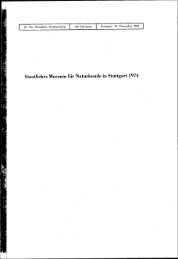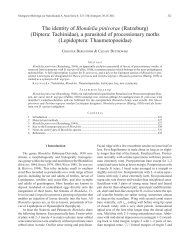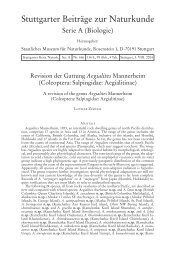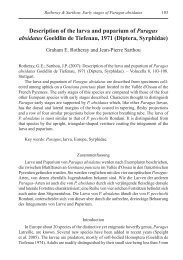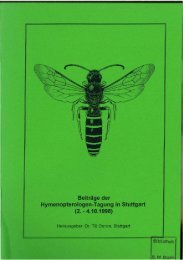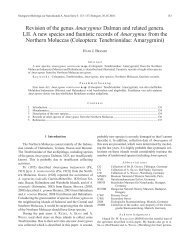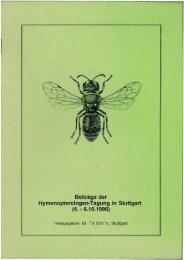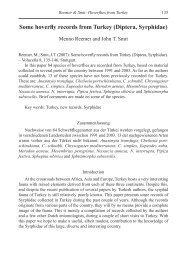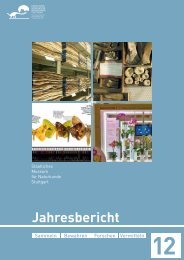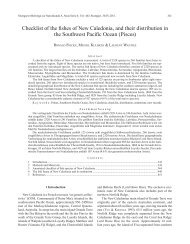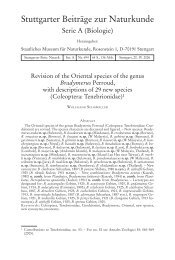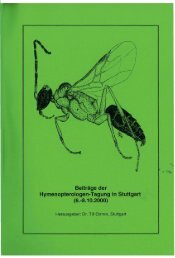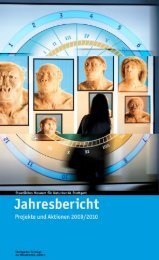170 STUTTGARTER BEITRÄGE ZUR NATURKUNDE ANeue Serie 6<strong>Bradymerus</strong> buergersi n. sp.(Figs. 2, 49)Holotype (♂): West Papua, Wandammen Bay, WondiwoiMts., Wasior, 300–850 m, 5.I.2001, leg. A. RIEDEL, SMNS.Paratypes: West Papua, Fakfak, 2 km E airstrip, 16.–18.VII.1996, leg. P. SCHÜLE & P. STÜBEN, 1 ex. SMNS. – West Papua,Jayawijaya Prov., Borma, 1000–1300 m, 12.–18.VIII.1992, leg.A. RIEDEL, 1 ex. SMNS. – West Papua, Jayawijaya Prov., Endoman,900–1200 m, 29.IX.1993, leg. A. RIEDEL, 2 ex. SMNS.– West Papua, 130 km SE Kaimana, Omba (= Yamor) River,1020 m, 9.–11.II.2011, leg. A. WEIGEL, 4 ex. NME. – Papua NewGuinea, Lae, XII.1977, leg. J. SEDLACEK, 6 ex. HNHM.Etymology: Named in honour <strong>of</strong> JOSEPH BÜRGERS (1881–1954), physician <strong>of</strong> the German “Kaiserin Augusta Fluß Expedition”1912–1913 to New Guinea, collecting zoological specimensfor the Berlin Museum <strong>of</strong> Natural History.Description: Dorsal view see Fig. 2, dorsal sideblackish without metallic shine, body length 9.0–12.0 mm.Genae not broader than eyes, frons with distinct supraorbitalfurrows and with feeble supraorbital keels. Last 6 antennomeresforming a club. Anterior corners <strong>of</strong> pronotumdistinctly protruding, lateral margin with distinct crenulation,pronotal disc convex, with rough and confluent punctation,before base in the middle with a large impunctatefield, with distinct lateral impressions, between punctureswith high granules; pronotum medially with longitudinalimpression. Elytra with punctural rows without striae,punctures deeply impressed, interval 1 flat and with a row<strong>of</strong> distinct granules, these sometimes confluent at base andconfluently keeled in posterior third, intervals 2, 4 flat andwithout granules, interval 6 flat and posteriorly with a row<strong>of</strong> granules, intervals 3, 5, 7 with distinct complete keels.Tibiae externally with indistinct keels; male tibiae withoutmodifications. Aedeagus see Fig. 49.Diagnosis: B. buergersi n. sp. belongs to the <strong>species</strong>group around the common B. principatus, and shareswith this <strong>species</strong> the large body size, the 6-segmented antennalclub, the genae not broader than eyes and the shapeand rough dorsal punctation <strong>of</strong> the pronotum, but can easilybe distinguished by the different aedeagus, by the largerimpunctate field at the pronotal base and by the elytralstructure with flat intervals 2, 4 without any granules andwith intervals 3, 5, 7 with distinct and high keels (compareFigs. 2, 10). B. macrogonus (Figs. 6, 51) has the genaebroader than eyes, a different elytral structure, and a differentaedeagus. See also under B. neuhaussi n. sp. (Figs. 7,52).<strong>Bradymerus</strong> cheesmanae n. sp.(Figs. 15, 39)Holotype (♂): West Papua, Japen Island, north coast, Tindaret,100 m, 21.XII.2000, leg. A. RIEDEL, SMNS.Paratypes: West Papua, Jayapura, Sentani, Cyclops Mts.,400–800 m, 7.VIII.1992, leg. A. RIEDEL, 1 ex. SMNS. – WestPapua, Jayapura, Sentani, Cyclops Mts., 950–1450 m, 3.X.1992,leg. A. RIEDEL, 1 ex. SMNS. – West Papua, Jayawijaya Prov.,Borme, 1000–1450 m, 12.–18.VIII.1992, leg. A. RIEDEL, 2 ex.SMNS. – West Papua, 50 km S Nabire, Pusppenssat, 730 m,20.II.1998, leg. A. WEIGEL, 1 ex. CAWW. – West Papua, 50 kmS Nabire, Flaga Road, Pusppenssat, 18.II.1998, leg. A. WEIGEL,1 ex. CRGT. – West Papua, Sorong, Dusun Meibo, 100–150 m,19.I.2001, leg. A. RIEDEL, 2 ex. SMNS. – West Papua, 18 km NEKaimana, 50–80 m, 21.–25.II.2011, leg. A. WEIGEL, 2 ex. NME,1 ex. CRGT. – West Papua, road 10 km NE Kaimana, 40 m,1.II.2011, leg. A. SKALE, 2 ex. CASH. – West Papua, 50 km SEKaimana, Triton Bay, Kamaka, 10–50 m, 2.–5.II.2011, leg.A. SKALE, 1 ex. NME. – West Papua (labelled as Dutch NewGuinea), Waigeo, Mt. Nok, camp 2 (Buffelhorn), VI.1938, leg.L. E. CHEESMAN, 1 ex. BMNH. – Papua New Guinea, MorobeProv., Bulolo, 900 m, 13.II.–13.III.1979, leg. J. SEDLACEK, 1 ex.HNHM. – Moluccan Islands, Morotai, W Daruba, Raja, 50–100 m, 18.XI.1999, leg. A. RIEDEL, 1 ex. SMNS.Etymology: Named in honour <strong>of</strong> LUCY EVELYN CHEESMAN(1881–1969), British entomologist and traveller, assisting as volunteerat the Natural History Museum, London, and collectingvarious insects on expeditions to the Marquesas and GalapagosIslands, as well as to New Guinea, the New Hebrides (now Vanuatu)and other Pacific Islands.Description: Dorsal view see Fig. 15, dorsal sideblackish without metallic shine, body length 5.2–7.0 mm.Genae not broader than eyes, frons with distinct supraorbitalfurrows but without distinct supraorbital keels. Last6 antennomeres forming a club. Anterior corners <strong>of</strong> pronotumprotruding, lateral margin with distinct crenulation,pronotal disc convex, with rough and confluent punctation,before base punctures more separate, between puncturespartly with high granules, so that the pronotal disc bears1 hump behind the middle and 1 hump on each side; pronotumbefore base with shallow transverse impression.Elytra with punctural rows without striae, punctures deeplyimpressed, intervals 1, 2 with distinct elongate granules,intervals 3–8 with distinctly elongate granules partly formingkeels. Tibiae externally with 3 keels; male tibiae withoutmodifications. Aedeagus see Fig. 39.Diagnosis: B. cheesmanae n. sp. is similar and relatedto B. lobicollis Gebien, 1922 (Fig. 29), both <strong>species</strong>share small body size, antenna with 6 antennomeres forminga club, elytral structure (compare (Figs. 15 and 29)and particularly the tibiae externally with three keels, anunusual character within the genus. Both <strong>species</strong> can beseparated by the form <strong>of</strong> the pronotum (lateral margin withdistinct crenulation and anterior corners shorter acute inB. cheesmanae n. sp., nearly smooth and anterior cornerslonger rounded in B. lobicollis), by the dorsal structure <strong>of</strong>the pronotum (with three high humps in B. cheesmanaen. sp., with three longitudinal impressions in B. lobicollis),and by the elytral structure (lateral margin with serriformtubercles in B. cheesmanae n. sp., nearly smooth in B. lobicollis).<strong>The</strong> aedeagus <strong>of</strong> B. lobicollis is unknown (onlyfemale available). See also under B. albertisi n. sp. and B.meyeri n. sp.
SCHAWALLER, BRADYMERUS FROM NEW GUINEA AND THE MOLUCCAN ISLANDS 171<strong>Bradymerus</strong> dahli n. sp.(Fig. 3)Holotype (♀): Papua New Guinea, Etappenberg, 19.IX.–8.X.1912, leg. S. LEDERMANN, MNB.Paratype: West Papua, Jayapura, Sentani, Cyclops Mts.,500–1100 m, 28.XII.2007, leg. A. RIEDEL, 1 ♀ SMNS.Etymology: Named in honour <strong>of</strong> KARL FRIEDRICH THEO-DOR DAHL (1856–1929), curator <strong>of</strong> the Zoological Museum inBerlin, and collector <strong>of</strong> <strong>Coleoptera</strong> during his zoological expedition1896–1897 to New Britain and Papua New Guinea.Description: Dorsal view see Fig. 3, dorsal sideblackish without metallic shine, body length 12.0–12.3 mm.Genae not broader than eyes, frons with distinct supraorbitalfurrows but without distinct supraorbital keels. Last5 antennomeres forming a club. Anterior corners <strong>of</strong> pronotumdistinctly protruding, lateral margin nearly smoothwithout crenulation, pronotal disc flat, with fine and separatepunctation, between punctures with a few granules;pronotum somewhat uneven and before base with shallowtransverse impression. Elytra with punctural rows withoutstriae, punctures deeply impressed, intervals distinctlyconvex and regular with a row <strong>of</strong> high granules. Tibiae externallywithout distinct keels; modifications <strong>of</strong> male tibiaeunknown (only females available). Aedeagus unknown.Diagnosis: B. dahli n. sp. is similar to B. helleriGebien, 1922 concerning large body size, shape <strong>of</strong> antennomeresand dorsal structure <strong>of</strong> elytra, but differs by theshape <strong>of</strong> the pronotum with longer protruding anterior corners,by flatter pronotal disc, and by distinctly larger andhigher elytral granules (compare Figs. 3 and 5).Remarks: This large <strong>species</strong> is easy to recognizeand this justifies its description on the basis <strong>of</strong> females.<strong>The</strong> similar and certainly related <strong>species</strong> B. helleri is alsoknown only from two females, thus the aedeagi cannot becompared.<strong>Bradymerus</strong> dohertyi n. sp.(Figs. 24, 41)Holotype (♂): West Papua, Fakfak, Mambuni to Buni,11.VII.1996, leg. P. SCHÜLE & P. STÜBEN, SMNS.Paratypes: Papua New Guinea, Karimui, 1000 m, II.1974,leg. J. SEDLACEK, 1 ex. HNHM. – West Papua, Raja Ampat Prov.,Salawati Island, Kalobo, 24.–28.I.2004, leg. A. SKALE, 1 ex.CRGT.Etymology: Named in honour <strong>of</strong> WILLIAM DOHERTY(1857–1901), American lepidopterologist, who collected notonly butterflies in southeastern Asia including New Guinea andeastern Africa, but also many other insects, and even birds (forWALTER ROTHSCHILD).Description: Dorsal view see Fig. 24, dorsal sideblackish without metallic shine, body length 7.3–9.0 mm.Genae not broader than eyes, frons with distinct supraorbitalfurrows but without distinct supraorbital keels. Last 5antennomeres forming a club. Anterior corners <strong>of</strong> pronotumdistinctly protruding, lateral margin with feeble crenulation,pronotal disc convex, with dense but not confluentpunctation, before base punctures more separate, betweenpunctures with a few granules; pronotum before base withshallow transverse impression. Elytra with punctural rowswithout striae, punctures deeply impressed, intervals 1–4flat and with a row <strong>of</strong> small and separate tubercles, intervals5–8 with longitudinal confluent, almost keeled tubercles.Tibiae externally without distinct keels; male tibiaewithout modifications. Aedeagus see Fig. 41.Diagnosis: B. dohertyi n. sp. belongs to the group <strong>of</strong><strong>species</strong> consisting <strong>of</strong> B. doleschalli (Fig. 4), B. nigerrimus(Fig. 9) and B. rugipleuris (Fig. 11) and can be recognizedby the shining black surface, by the convex pronotum withoutany impressions, and by the elytra with the intervals1–4 flat and with small and separate tubercles and with theintervals 5–8 with confluent, nearly keeled tubercles. In theother <strong>species</strong>, only the intervals 1 or 1–2 bear tubercles andthe intervals 3–8 bear keels. Additionally, B. rugipleurishas the pronotum medially with a longitudinal impression.<strong>Bradymerus</strong> lorentzi n. sp.(Fig. 28)Holotype (♀): Moluccan Islands, Seram, 35 km E Pasahari,Unit O, 24.–30.X.1998, leg. O. MEHL, HNHM.Etymology: Named in honour <strong>of</strong> HENDRIKUS ALBERTUSLORENTZ (1871–1944), Dutch jurist and biologist, leader <strong>of</strong> twoNetherland expeditions to New Guinea 1907–1910.Description: Dorsal view see Fig. 28, dorsal sideblackish without metallic shine, body length 5.7 mm. Genaenot broader than eyes, frons with distinct supraorbitalfurrows but without distinct supraorbital keels. Last 5 antennomeresforming a club. Anterior corners <strong>of</strong> pronotumprotruding, lateral margin with crenulation, pronotal discdistinctly convex, with rough and confluent punctation,before base punctures more separate, between punctureswithout granules; pronotum before base with shallowtransverse impression. Elytra with punctural rows withoutstriae, punctures deeply impressed, interval 1 feeblyconvex and with a row <strong>of</strong> few and tiny granules, intervals2–8 with complete, slightly sinuate keels. Tibiae externallywith distinct keels; modifications <strong>of</strong> male tibiae unknown(only female available). Aedeagus unknown.Diagnosis: B. lorentzi n. sp. can be recognized bythe small body size, the distinctly convex pronotum withrough confluent punctation but without medially longitudinalimpression, the pronotum with long acute anteriorcorners, the elytra with similarly keeled intervals 2–8, andthe tibiae with distinct external keel. No similar <strong>species</strong> isknown in the studied area. B. archboldi n. sp. has also a
- Page 1 and 2: Stuttgarter Beiträge zur Naturkund
- Page 3 and 4: SCHAWALLER, BRADYMERUS FROM NEW GUI
- Page 5 and 6: SCHAWALLER, BRADYMERUS FROM NEW GUI
- Page 7 and 8: SCHAWALLER, BRADYMERUS FROM NEW GUI
- Page 9 and 10: SCHAWALLER, BRADYMERUS FROM NEW GUI
- Page 11 and 12: SCHAWALLER, BRADYMERUS FROM NEW GUI
- Page 13 and 14: SCHAWALLER, BRADYMERUS FROM NEW GUI
- Page 15 and 16: SCHAWALLER, BRADYMERUS FROM NEW GUI
- Page 17 and 18: SCHAWALLER, BRADYMERUS FROM NEW GUI
- Page 19: SCHAWALLER, BRADYMERUS FROM NEW GUI
- Page 23 and 24: SCHAWALLER, BRADYMERUS FROM NEW GUI



